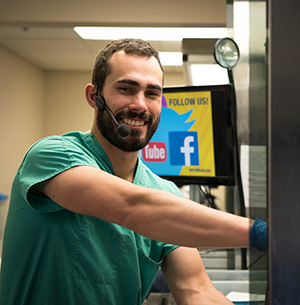- Position
- Associate Professor and Vice Chair; Pathology Residency Program Director; Cytopathology Director, Pathology, Anatomy and Laboratory Medicine
- Phone
- 304-293-0198
Surgical Pathology
Surgical pathology provides surgeons and various clinicians with important diagnoses and other relevant information, often crucial to a patient’s treatment, prognosis and overall care. The Gross Room is the pathology laboratory where specimens are processed and handled on a routine basis. Depending on the type of specimen, ranging from small biopsies to amputations and large tumors, a specific protocol is used to dissect each and every specimen. After the dissection is complete, certain portions of tissue are submitted to the histology laboratory where they are turned into glass slides that can be viewed under a microscope. From here, the pathologist makes his or her final diagnosis.  Each year, the WVU Department of Pathology processes approximately 30,000 surgical specimens; a significant number of these are complex resections. The majority of specimens are processed in the Gross Surgical Pathology Lab.
Each year, the WVU Department of Pathology processes approximately 30,000 surgical specimens; a significant number of these are complex resections. The majority of specimens are processed in the Gross Surgical Pathology Lab.
The surgical pathology lab is located on the 5th floor of Ruby Memorial Hospital, just outside of the main operating room area. This location is exceptionally convenient because it allows for easy access to surgeons and surgical residents.
Approximately 40% of the surgical pathology workload consists of biopsy specimens. The majority of which are skin, OB-GYN and GI. The remaining cases are comprised of a wide variety of neoplastic and non-neoplastic conditions.
WVU has extremely active programs in ENT, OB-GYN, Pediatric, Cardio-thoracic, and general surgical oncology. The diversity of these services ensures that a wide range of specimens is received on the surgical pathology bench.
In addition, the surgical pathology service provides frozen section support to the above named services. Each year, approximately 1000 frozen section specimens are handled in the Ruby Memorial Gross Room.
The WVUH gross room is staffed by a team of highly trained technicians and one to two pathology residents who are supervised by a pathologist’s assistant (PA). Frozen sections are covered by the pathology residents and an attending surgical pathologist. The majority of gross room decisions are handled by the PA under the authority of the director of anatomic pathology (AP). The PA provides day-to-day teaching support for both junior residents and medical students. In addition the PA also serves as a consistent liaison between the OR and surgical pathologist.
Surgical Pathologists
- Position
- Assistant Professor, Pathology, Anatomy and Laboratory Medicine
- Phone
- 304-293-1608
- Position
- Associate Professor, Pathology, Anatomy and Laboratory Medicine
- Phone
- 304-293-1613
- Position
- Assistant Professor, Department of Pathology, Anatomy & Laboratory Medicine, Pathology, Anatomy and Laboratory Medicine
- Position
- Assistant Professor, Pathology, Anatomy and Laboratory Medicine
- Phone
- 304-293-1628
- Position
- Assistant Professor, Pathology, Anatomy and Laboratory Medicine
- Phone
- 304-293-1337
- Position
- Professor, Pathology, Anatomy and Laboratory Medicine
- Phone
- 304-293-6633
- Position
- Assistant Professor, Pathology, Anatomy and Laboratory Medicine
- Phone
- 304-293-5415
- Position
- Assistant Professor and Cytopathology Fellowship Program Director, Pathology, Anatomy and Laboratory Medicine
- Phone
- 304-293-2093
- Positions
- Associate Professor, Pathology, Anatomy and Laboratory Medicine
- Member, WVU Cancer Institute Research Programs
- Phone
- 304-293-3404
- Position
- Professor, Pathology, Anatomy and Laboratory Medicine
- Phone
- 304-293-6403
- Position
- Pathology, Anatomy and Laboratory Medicine
- Position
- Assistant Professor SOM, Pathology, Anatomy and Laboratory Medicine